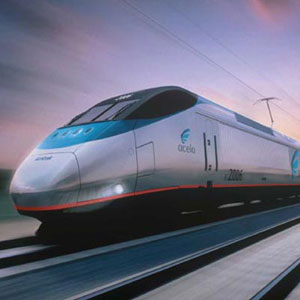Trains are cool. And fast trains are fastly cool.
I live nearly 15 miles from my office. And I would love to be able to take a train, preferably a fast one, to the office each day. However, there are some constraints on even an imaginary train.
- I have to take my kids to school. So, even if I can take the train to work, I have to drive to school.
- My kids would appreciate it if I picked them up.
- Sometimes, more when they were younger, I have to go to school to get them because they are hurt or sick.
- Now that they are older, they need to go to places like dance, karate, soccer and basketball after school.
- I have to go to places like lunch, the grocery store and Wal-mart during the day.
All of this is a not so obvious way of saying that unless the train stopped at my door, my kid’s school, the grocery and each of our events, I can’t use it. None of the things in my life are close enough that I can afford to give up the car.
My wife was born in Brooklyn. And I love to visit. Everything is so close to the house that you can go for days, weeks I suspect, without having to go further than 6 blocks. Within just 2 are more than 20 places to eat, a movie theater, grocery and drug stores. Everything.
But here, in Raleigh, and most place sin America, things that people need and want are spread all over the place. And because of that, trains, being static once built, are of very limited use to a very limited population of people.
And saying that makes me happy:
“The commuter rail plan and the light rail plan just don’t make sense to me,” said John Pucher, a professor in the Bloustein School of Planning and Public Policy at Rutgers University in New Jersey. He is a visiting professor this semester at the University of North Carolina-Chapel Hill in the Department of City and Regional Planning.
Pucher has more than 40 years of experience in transportation planning. He supports alternative modes of transportation, but he said planners often underestimate cost and overestimate ridership projections.
“It’s just so difficult in this very decentralized, very sprawled metropolitan area,” he said.
I wish I could take a train to work. Maybe in 12 years after the kids are in college and I have fewer variable trips, I can. In fact, when I was single and living in Seattle, I often had thoughts of moving to Bainbridge Island and commuting by ferry. I could arrange to work from home in the morning, miss the massive morning commute, take the boat across and be in the office by 10. Same thing on the way home.
But right now, the way that we have built our cities, the juice ain’t worth the squeeze on this light rail. The money just doesn’t make sense.
But what does?
A better option for Wake County would be a “bus rapid transit system,” he said. The system essentially allows buses to use high-occupancy vehicle lanes on area highways, which he said is more efficient, flexible and cost-effective than rail systems.
Indeed.


In Washington and its surround suburbs, the very act of putting in subway lines and stops changed development in the neighborhoods around those stops/lines. If you fly into National airport over the city you’d be able to guess where a number of the metro stops are just by looking at the higher density development crowded around those stops. The DC burbs remain a traffic-clogged sprawling mess, but the rail system has brought some relief. My point being that, if done the right way, a rail line can actually encourage higher density development of an area. I’m not saying that’s the answer for Raleigh, though.
In Washington and its surround suburbs, the very act of putting in subway lines and stops changed development in the neighborhoods around those stops/lines.
Fair point.
If you google map Raleigh and look at development around the 540 loop, you can see which exits were developed first; neighborhoods are thicker there.
Perhaps a better point would be that such decisions need to be taken into context. Further, that cost per rider should be taken into account as well.
I’ve taken the Metro and it is great for getting into DC . I suppose the density of population justifies it . I doubt that California’s high speed rail project benefits anyone other than the workers and corporations building it, and the politicians promoting it .
Lest we forget, cities used to develop around rail lines . Government policy helped kill rail service by subsidizing competing transportation . It is always amusing how after government kills something, it is compelled to resurrect and subsidize it’s corpse .
I suppose the density of population justifies it .
I think that an important metric is to determine the cost per trip. Look at some of those numbers in some of the cities that have built it and it’s just crazy.